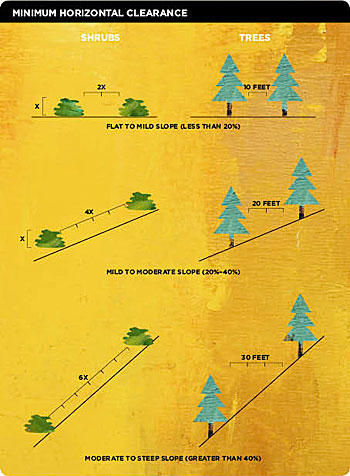By Mike Conrad, Aptos La Selva Fire District

You have seen to it that your roof and rain gutters have been cleared of all leaves and needles. You have made sure that the thirty feet immediately around your home is park-like by removing dead or dying vegetation. Keeping the grass mowed short and pruning tree branches away from your roof and 10 feet away from the chimney. The firewood has been moved out of the 30 feet radius around your home and you have provided horizontal separation between trees and bushes.
You have prepared the next 70 feet or to your property line by keeping grass and weeds mowed to a maximum 4 inches high and you have continued with the horizontal spacing around shrubs and trees and you included vertical spacing between shrubs and trees. This provides a reduction of the ladder fuels to keep ground fires from getting into the trees.
All gates to your property open inward and are wide enough to accommodate emergency equipment. Your driveway has been cleared of obstructions that would interfere with a fire engine accessing your property. Access roads have a minimum of 10 feet of clearance on either side for two-way traffic and trees and shrubs overhanging the road have been trimmed to allow emergency vehicles to pass.
So, sit back and enjoy the fruits of your labor … BUT if you have not taken these steps necessary to protect your home, set the ice tea down and get to work. And there is more you can do to harden your home to help it withstand a wildland fire.
Things you can do to harden your home to make it more fire resistant.
Flying embers can destroy homes up to a mile from a wildfire. “Harden” your home now before a fire starts by using ember-resistant building materials.
Roof: The roof is the most vulnerable part of your home. Homes with wood or shingle roofs are at high risk of being destroyed during a wildfire. Build or re-roof with materials such as composition, metal or tile.
Vents: Vents on homes create openings for flying embers.
- Cover all vent openings with 1/8-inch to 1/4-inch metal mesh. Do not use fiberglass or plastic mesh because they can melt and burn.
- Protect vents in eaves or cornices with baffles to block embers (mesh is not enough).
Eaves and Soffits: Eaves and soffits (underside of eaves) should be protected with ignition-resistant or non-combustible materials.
Decks: Surfaces within 10 feet of the building should be built with ignition-resistant, non-combustible, or other approved materials, and remove all combustible items from underneath your deck.
Patio Cover: Use the same ignition-resistant materials for patio coverings as a roof.
Chimney: Cover your chimney and stovepipe outlets with a non-combustible screen. Use metal screen material with openings no smaller than 3/8-inch and no larger than 1/2-inch to prevent embers from escaping and igniting a fire.
Garage: Have a fire extinguisher and tools such as a shovel, rake, bucket, and hoe available for fire emergencies.
- Install weather stripping around and under the garage door to prevent embers from blowing in.
- Store all combustible and flammable liquids away from ignition sources.
Water Supply: Consider having multiple garden hoses that are long enough to reach all areas of your home and other structures on your property. If you have a swimming pool, consider getting a pump.
For more information please contact your local fire department or visit the Cal Fire website at www.readyforwildfire.org